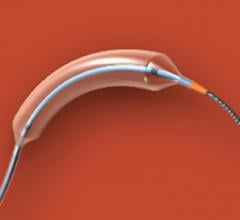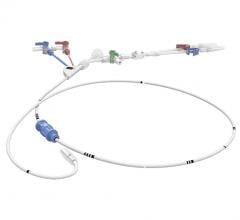
July 26, 2017 — The Spectranetics Corp. announced receipt of U.S. Food and Drug Administration (FDA) pre-market approval (PMA) of the Stellarex drug-coated balloon (DCB). The device is designed to restore and maintain blood flow to the superficial femoral and popliteal arteries in patients with peripheral arterial disease (PAD).
This is the third drug-coated balloon to gain FDA clearance, joining the previously cleared Medtronic In-Pact Admiral and the C.R. Bard Lutonix. Read about the first FDA approvals in the article “Drug-eluting Balloons Enter the U.S. Market.”
The Stellarex DCB has shown safety and efficacy in a cohort of patients which included a higher preponderance of diabetics and core-lab defined severely calcified lesions in the U.S. investigational device exemption (IDE) trial. These results, in combination with the cohort of patients studied in the European Randomized Controlled Trial, demonstrate the Stellarex DCB is safe and effective in diverse patient populations when addressing symptomatic femoropopliteal disease,” stated Prakash Krishnan, M.D., ILLUMENATE Pivotal Trial’s co-principal investigator, Mount Sinai in New York.
Sean Lyden, M.D., ILLUMENATE Pivotal Trial’s co-principal investigator, Cleveland Clinic, Cleveland, Ohio added, “The ILLUMENATE Pivotal Trial treated a challenging patient population with a low paclitaxel drug dose. When considering options, I think most clinicians would prefer to use a lower drug dose if they can also achieve great patency results.”
Throughout the ILLUMENATE Trial Series, the Stellarex DCB’s EnduraCoat Technology demonstrates both safety and efficacy with consistently high patency rates and low clinically driven target lesion revascularization rates in a range of lesion complexities and patient co-morbidities. The device offers both hybrid paclitaxel crystallinity and a durable excipient to provide efficient drug transfer, effective drug residency with high coating durability and minimal particulate loss.
There are five ILLUMENATE clinical studies evaluating the safety and efficacy of the Stellarex DCB platform and supporting United States regulatory filings:
- The ILLUMENATE EU Randomized Study is a prospective, randomized controlled, multi-center trial with 328 patients. The primary safety and effectiveness endpoints at 12 months were met and superiority over percutaneous transluminal angioplasty (PTA) was demonstrated in both. The 12-month primary patency rate was 83.9 percent (188/224) in the Stellarex arm vs. 60.6 percent (40/66) in the PTA arm (P<0.001), per Kaplan Meier (KM) estimate the patency rate at day 365 was 89 percent vs. 65 percent, respectively (log-rank p<0.001);
- The ILLUMENATE Pivotal Study is a prospective, randomized controlled, multi-center trial with 300 patients enrolled. The cohorts were well match and included a preponderance of patients with diabetes (50 percent) and severely calcified lesions (44 percent). The primary safety and effectiveness endpoints at 12 months were met and superiority over PTA was demonstrated in both. The primary patency rate was significantly higher in the Stellarex group at 76.3 percent (135/177) vs. 57.6 percent (53/92) for PTA (p=0.003). The 12-month primary patency rate, per KM estimate at day 365 was 82.3 percent in the DCB arm vs. 70.9 percent in the PTA arm (p=0.002);
- The ILLUMENATE Global Study is a prospective, multi-center, single-arm study with 371 patients enrolled. The 12-month primary patency rate was 81.4 percent per KM estimate;
- The ILLUMENATE First-In-Human (FIH) Study was a non-randomized, multi-center study that enrolled 80 patients. In the pre-dilatation arm (n=50), the primary patency rate per KM estimate was 89.5 percent at 12 months and 80.3 percent at 24 months; and
- The ILLUMENATE Pharmacokinetic Study measured the paclitaxel drug levels in the blood of 25 patients and showed all patients had detectable paclitaxel levels after DCB deployment that declined rapidly within the first hour (54.4±116.9 ng/mL to 1.4±1.0 ng/mL).
Covidien originally developed the Stellarex and gained European CE mark approval in January 2015. In 2015, Covidien sold the Stellarex DCB platform to Spectranetics. Spectranetics received Eurpean CE mark approval for a 0.014-inch version of the device in late 2016.
Watch the VIDEO “Drug-coated Balloons Enter the U.S. Market,” and interview with Doug Drachman, M.D., Mass General Hospital, who served a the site principal investigator for the Lutonix balloon trial.
For more information: www.spectranetics.com


 April 04, 2024
April 04, 2024 








